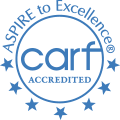Here at Wellness Resource Center, our clinical team utilizes Dialectical Behavior Therapy, commonly referred to as “DBT” for short, as one of the therapeutic modalities that make up our dual diagnosis treatment programming. Many clients come to Wellness specifically because of the DBT component of our program. They do so because DBT has proven to be an effective therapy for treating a varied group of co-occurring disorders, such as self-harm, suicidal thinking, and borderline personality disorder. Additionally, use of DBT has shown to positively impact behavioral health issues such as poor anger management, depression and panic / anxiety issues, as well as mood disorders and other mental health concerns characterized by a lack of emotional self-regulation. But what exactly is DBT?
The History of Dialectical Behavior Therapy
DBT is a modern off-shoot of a larger school of psychotherapeutic thinking, behavioral therapy, referred to in the past as Behaviorism. Behavioral therapy or Behaviorism first emerged at the turn of the Twentieth Century as a reaction to the psychoanalytic school of psychology made famous by Sigmund Freud. Early Behaviorists criticized psychoanalysis for its lack of measurable effectiveness, and set out to create a more empirical, evidence-based psychotherapeutic approach. Unlike psychoanalysis, behavioral therapy focused on the conditioned development of behaviors, both healthy and maladaptive, due to environmental causes, and how to unlearn those conditioned behaviors if they became detrimental.
One of the systems that emerged out the school of behavioral therapy was Cognitive Behavioral Therapy (CBT), a type of therapy that is still used widely today, including at Wellness Resource Center. CBT is a merger of behavioral therapy and cognitive therapy – Cognition meaning the action of acquiring knowledge through thoughts, experiences, and senses. Cognitive behavioral approaches focus on how emotional disturbances emanate from the meaning we find, language we use, and belief systems we apply to unfortunate events and circumstances, not the event and circumstances themselves. Dialectical Behavior Therapy, created in the late 1980s by the American psychologist Marsha Linehan, merged many of the components of CBT with more Eastern philosophic principles such as acceptance and mindfulness.
How DBT Works
Dialectical Behavior Therapy breaks down across four distinct modules that each address a problem area for clients struggling with mood or personality disorders: Mindfulness, Distress Tolerance, Emotional Regulation, and Interpersonal Effectiveness. DBT incorporates slogans and mnemonic devices like acronyms to help clients internalize the procedures and thus better apply them in their everyday lives. Examples of these memory devices include:
- GIVE: An acronym for Gentle, Interested, Validating, Easy mannered. GIVE is a simplification of a skill taught within the Interpersonal Effectiveness module of DBT, to help practitioners better maintain relationships, something that can be sorely lacking in those with unhealthy defense mechanisms like isolation and outwardly aggressive tendencies.
- “Observe, Describe, Participate”: A tactic for non-judgmentally processing events and environments taught under the Mindfulness module. Clients are encouraged to dispassionately observe their surroundings, like a journalist, describe everything objectively, and then actively participate in any activity at hand in a mindful and focused way. Skills like this one and others under the Mindfulness module combat extreme, black-and-white thinking patterns.
- “The Story of Emotion”: A technique borrowed from Cognitive Behavioral Therapy, this skill-set directs clients to itemize the different stages of an emotional reaction in sequential order, so as to interrupt their emotional disturbance pattern and gain a better understanding of their reactions. In this exercise, clients categorize the following parts to an emotional response:
- Prompting event
- Interpretation of the event
- Body sensations
- Body language:
- Action urge
- Action
- Emotion name [clients are provided with a list of emotions in order to articulate feelings]
These are just a few examples of tools taught in DBT groups and individual therapy sessions. Each DBT module has a suite of skill-sets that are learned, explored, and applied to every individual’s unique situation.
DBT and Recovery from Addiction & Alcoholism
Almost all the skill-sets taught in Dialectical Behavior Therapy are applicable to recovery from drug and alcohol abuse, as well as recovery from dually diagnosed disorders, and studies have shown its efficacy in treating both types of patients. Many of the techniques taught in DBT to promote emotional regulation, such as distress tolerance, mindfulness, and the use of healthy distractions and self-soothing, are also great ways to combat addiction triggers, cravings, and common stressors for those in early recovery from drug abuse or alcoholism.
DBT also works well in congruence with participation in a 12-step program of recovery, like Alcoholics Anonymous or Narcotics Anonymous. Indeed, many of the skills taught in DBT are echoed in AA/NA, only using different language. For example, in AA individuals are encouraged to understand that the outside world is beyond their control, and to understand that what they do control is their internal reaction to disturbances. This coincides neatly with DBT’s concept of a “teflon mind,” non-judgmentally observing one’s environment and allowing events and feelings to pass without assigning greater significance. The concept of acceptance is another tenet central to both practices, as well as an emphasis on meditation and mindfulness.
How DBT is Implemented at Wellness Resource Center
At Wellness Resource Center in Boca Raton, Florida, Dialectical Behavior Therapy is used in our curriculum in two different ways:
- Psycho-educational Group Therapy: Wellness facilitates DBT groups multiple times a week, led by a DBT-specific therapist. In the groups, clients are taught different DBT skills and coping strategies, rotating through the four DBT modules. Clients are also given assignments and homework to apply outside of group. A common complaint is that the groups can become redundant as skill-sets are often reviewed more than once, but repetition is part of the effectiveness of DBT; strategies must be drilled into the subject until they are second nature, so that the likelihood of those strategies being used in times of emotional turmoil is increased.
- Individual Therapy Sessions: All of our primary therapists are well-versed in DBT modalities. Individual psychotherapy is an important aspect of turning learned DBT skills into a continuous coping strategy in the outside world. In individual therapy, our therapists work to help clients improve insight and motivation, so that they can identify instances where DBT skills need to be applied. Ancillary to our primary therapist treatment team, Wellness Resource Center also has a DBT-specific therapist on staff to provide additional one-on-one DBT therapy to clients if needed.
Too often individuals struggling with mental health disorders typified by lack of distress tolerance and emotional regulation self-medicate by drinking, using illicit mind or mood altering substances, or by abusing prescription medications. In order for DBT to be effective for dual diagnosis clients, it must be paired with long term abstinence-based recovery. If someone is still masking emotional conflict through substance use, those emotions are never able to surface and therefore cannot be addressed in a healthy way through therapy. In addition to illicit drug abstinence, many clients also require proper medication in conjunction with DBT, in order to treat any post-acute withdrawal symptoms (PAWS) or inherent chemical imbalances due to a mood disorder and/or prolonged addiction.
If you or someone you care about is currently struggling with addiction and emotional disruption, please contact Wellness Resource Center today to find out more about our DBT and other dual diagnosis treatment programs.












